
Hãy nhập câu hỏi của bạn vào đây, nếu là tài khoản VIP, bạn sẽ được ưu tiên trả lời.


Bài 2:
b) Phương trình hoành độ giao điểm của (P) và (d) là:
\(2x^2=-x+3\)
\(\Leftrightarrow2x^2+x-3=0\)
\(\Leftrightarrow2x^2-2x+3x-3=0\)
\(\Leftrightarrow2x\left(x-1\right)+3\left(x-1\right)=0\)
\(\Leftrightarrow\left(x-1\right)\left(2x+3\right)=0\)
\(\Leftrightarrow\left[{}\begin{matrix}x-1=0\\2x+3=0\end{matrix}\right.\Leftrightarrow\left[{}\begin{matrix}x=1\\x=-\dfrac{3}{2}\end{matrix}\right.\)
Thay x=1 vào hàm số \(y=2x^2\), ta được:
\(y=2\cdot1^2=2\)
Thay \(x=-\dfrac{3}{2}\) vào hàm số \(y=2x^2\), ta được:
\(y=2\cdot\left(-\dfrac{3}{2}\right)^2=2\cdot\dfrac{9}{4}=\dfrac{9}{2}\)
Vậy: Tọa độ giao điểm của (p) và (D) là (1;2) và \(\left(-\dfrac{3}{2};\dfrac{9}{2}\right)\)

a) Điều kiện x ≥ 1; y ≥ 1.
Đặt  (u, v ≥ 0).
(u, v ≥ 0).
Hệ phương trình trở thành:
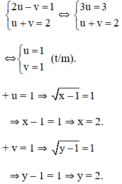
Vậy hệ phương trình có nghiệm (2; 2).
b) Đặt (x – 1)2 = u, u ≥ 0.
Hệ phương trình trở thành:
u − 2 y = 2 3 u + 3 y = 1 ⇔ 3 u − 6 y = 6 3 u + 3 y = 1 ⇔ − 9 y = 5 u − 2 y = 2 ⇔ y = − 5 9 u = 8 9 + u = 8 9 ⇒ ( x − 1 ) 2 = 8 9 ⇔ x − 1 = 2 2 3 x − 1 = − 2 2 3 ⇔ x = 2 2 + 3 3 x = − 2 2 + 3 3
Vậy hệ phương trình có hai nghiệm 

Bài toán này có hai cách giải:
Cách 1: Thu gọn từng phương trình ta sẽ thu được phương trình bậc nhất hai ẩn x và y.
Cách 2: Đặt ẩn phụ.
Cách 1:

 (hệ số của y bằng nhau nên ta trừ từng vế hai phương trình)
(hệ số của y bằng nhau nên ta trừ từng vế hai phương trình)
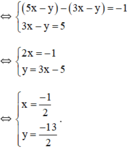
Vậy hệ phương trình có nghiệm duy nhất 
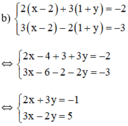
(Nhân hai vế pt 1 với 2; pt 2 với 3 để hệ số của y đối nhau)
 (Hệ số của y đối nhau nên ta cộng từng vế của hai pt)
(Hệ số của y đối nhau nên ta cộng từng vế của hai pt)
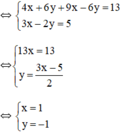
Vậy hệ phương trình có nghiệm duy nhất (1; -1).
Cách 2:
a) Đặt x + y = u và x – y = v (*)
Khi đó hệ phương trình trở thành
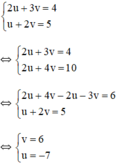
Thay u = -7 và v = 6 vào (*) ta được hệ phương trình:
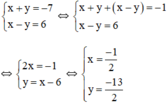
Vậy hệ phương trình có nghiệm 
b) Đặt x – 2 = u và y + 1 = v.
Khi đó hệ phương trình trở thành :
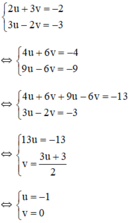
+ u = -1 ⇒ x – 2 = -1 ⇒ x = 1.
+ v = 0 ⇒ y + 1 = 0 ⇒ y = -1.
Vậy hệ phương trình có nghiệm (1; -1).
a) Điều kiện x ≥ 1; y ≥ 1.
Đặt (u, v ≥ 0).
(u, v ≥ 0).
Hệ phương trình trở thành:
Vậy hệ phương trình có nghiệm (2; 2).
b) Đặt ( x – 1 ) 2 = u , u ≥ 0.
Hệ phương trình trở thành:
Vậy hệ phương trình có hai nghiệm